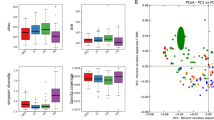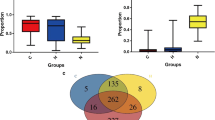Abstract
Background
The intestinal microbiome is involved in the pathogenesis of chronic kidney disease (CKD). Despite its importance, the microbiome of the small intestinal mucosa has been little studied due to sampling difficulties, and previous studies have mainly focused on fecal sources for microbiome studies. We aimed to characterize the small intestinal microbiome of CKD patients by studying the microbiome collected from duodenal and fecal samples of CKD patients and healthy controls.
Methods
Overall, 28 stage 5 CKD patients and 21 healthy participants were enrolled. Mucosal samples were collected from the deep duodenum during esophagogastroduodenoscopy and fecal samples were also collected. The 16S ribosomal RNA gene sequencing using Qiime2 was used to investigate and compare the microbial structure and metagenomic function of the duodenal and fecal microbiomes.
Results
The duodenal flora of CKD patients had decreased alpha diversity compared with the control group. On the basis of taxonomic composition, Veillonella and Prevotella were significantly reduced in the duodenal flora of CKD patients. The tyrosine and tryptophan metabolic pathways were enhanced in the urea toxin-related metabolic pathways based on the Kyoto Encyclopedia of Genes and Genomes database.
Conclusion
The small intestinal microbiome in CKD patients is significantly altered, indicating that increased intestinal permeability and production of uremic toxin may occur in the upper small intestine of CKD patients.






Similar content being viewed by others
References
Jha V, Garcia-Garcia G, Iseki K, et al. Chronic kidney disease: global dimension and perspectives. Lancet. 2013;382:260–72.
Agus A, Planchais J, Sokol H. Gut Microbiota Regulation of Tryptophan Metabolism in Health and Disease. Cell Host Microbe. 2018;23:716–24.
Mishima E, Fukuda S, Mukawa C, et al. Evaluation of the impact of gut microbiota on uremic solute accumulation by a CE-TOFMS-based metabolomics approach. Kidney Int. 2017;92:634–45.
Koeth RA, WangLevison ZB, et al. Intestinal microbiota metabolism of L-carnitine, a nutrient in red meat, promotes atherosclerosis. Nat Med. 2013;19:576–85.
Vaziri ND, Yuan J, Rahimi A, Ni Z, Said H, Subramanian VS. Disintegration of colonic epithelial tight junction in uremia: a likely cause of CKD-associated inflammation. Nephrol Dial Transplant. 2012;27:2686–93.
Sun CY, Chang SC, Wu MS. Uremic toxins induce kidney fibrosis by activating intrarenal renin-angiotensin-aldosterone system associated epithelial-to-mesenchymal transition. PLoS ONE. 2012;7:e34026.
Vanholder R, Schepers E, Pletinck A, Nagler EV, Glorieux G. The uremic toxicity of indoxyl sulfate and p-cresyl sulfate: a systematic review. J Am Soc Nephrol. 2014;25:1897–907.
Sabatino A, Regolisti G, Brusasco I, Cabassi A, Morabito S, Fiaccadori E. Alterations of intestinal barrier and microbiota in chronic kidney disease. Nephrol Dial Transplant. 2015;30:924–33.
Darisipudi MN, Knauf F. An update on the role of the inflammasomes in the pathogenesis of kidney diseases. Pediatr Nephrol. 2016;31:535–44.
Meijers BK. Evenepoel P The gut-kidney axis: indoxyl sulfate, p-cresyl sulfate and CKD progression. Nephrol Dial Transplant. 2011;26:759–61.
Nagasue T, Hirano A, Torisu T, et al. The Compositional Structure of the Small Intestinal Microbial Community via Balloon-Assisted. Enteroscopy Digest. 2022;103:308–18.
Leite GGS, Weitsman S, Parodi G, et al. Mapping the Segmental Microbiomes in the Human Small Bowel in Comparison with Stool: A REIMAGINE Study. Dig Dis Sci. 2020;65:2595–604.
Stremmel W, Schmidt KV, Schuhmann V, et al. Blood Trimethylamine-N-Oxide Originates from Microbiota Mediated Breakdown of Phosphatidylcholine and Absorption from Small Intestine. PLoS ONE. 2017;12: e0170742.
Meier KHU, Trouillon J, Li Het al. . Metabolic landscape of the male mouse gut identifies different niches determined by microbial activities Nat Metab. 2023.
Hirano A, Umeno J, Okamoto Yet al. Comparison of the microbial community structure between inflamed and non-inflamed sites in patients with ulcerative colitis J Gastroenterol Hepatol. 2018.
Bolyen E, Rideout JR, Dillon MRet al. . Reproducible, interactive, scalable and extensible microbiome data science using QIIME 2 Nat Biotechnol. 2019;37:852–857.
Quast C, Pruesse E, Yilmaz P, et al. The SILVA ribosomal RNA gene database project: improved data processing and web-based tools. Nucleic Acids Res. 2013;41:D590-596.
Douglas GM, Maffei VJ, Zaneveld JR, et al. PICRUSt2 for prediction of metagenome functions. Nat Biotechnol. 2020;38:685–8.
Caspi R, Billington R, Keseler IMet al. The MetaCyc database of metabolic pathways and enzymes - a 2019 update Nucleic Acids Res. 2020;48:D445-d453.
Parks DH, Tyson GW, Hugenholtz P, Beiko RG. STAMP: statistical analysis of taxonomic and functional profiles Bioinformatics. 2014;30:3123–3124.
Hobby GP, Karaduta O, Dusio GF, Singh M, Zybailov BL, Arthur JM. Chronic kidney disease and the gut microbiome. Am J Physiol Renal Physiol. 2019;316:F1211-f1217.
Li F, Wang M, Wang J, Li R, Zhang Y. Alterations to the gut microbiota and their correlation with inflammatory factors in chronic kidney disease. Front Cell Infect Microbiol. 2019;9:206.
Wu IW, Gao SS, Chou HC, et al. Integrative metagenomic and metabolomic analyses reveal severity-specific signatures of gut microbiota in chronic kidney disease. Theranostics. 2020;10:5398–411.
Shin NR, Whon TW, Bae JW. Proteobacteria: microbial signature of dysbiosis in gut microbiota. Trends Biotechnol. 2015;33:496–503.
Hu J, Iragavarapu S, Nadkarni GN, et al. Location-Specific Oral Microbiome Possesses Features Associated With CKD Kidney. Int Rep. 2018;3:193–204.
Kim JE, Kim HE, Park JIet al. . The Association between Gut Microbiota and Uremia of Chronic Kidney Disease Microorganisms. 2020;8.
Jiang S, Xie S, Lv D, et al. Alteration of the gut microbiota in Chinese population with chronic kidney disease. Sci Rep. 2017;7:2870.
Furusawa Y, Obata Y, Fukuda S, et al. Commensal microbe-derived butyrate induces the differentiation of colonic regulatory T cells. Nature. 2013;504:446–50.
Devlin AS, Marcobal A, Dodd D, et al. Modulation of a Circulating Uremic Solute via Rational Genetic Manipulation of the Gut Microbiota. Cell Host Microbe. 2016;20:709–15.
Di Iorio BR, Rocchetti MT, De Angelis Met al. . Nutritional Therapy Modulates Intestinal Microbiota and Reduces Serum Levels of Total and Free Indoxyl Sulfate and P-Cresyl Sulfate in Chronic Kidney Disease (Medika Study) J Clin Med. 2019;8.
Wheeler R, Bastos PAD, Disson O, et al. Microbiota-induced active translocation of peptidoglycan across the intestinal barrier dictates its within-host dissemination. Proc Natl Acad Sci USA. 2023;120: e2209936120.
Asao T, Oki K, Yoneda M, Tanaka J, Kohno N. Hypothalamic-pituitary-adrenal axis activity is associated with the prevalence of chronic kidney disease in diabetic patients. Endocr J. 2016;63:119–26.
Banoglu E, Jha GG, King RS. Hepatic microsomal metabolism of indole to indoxyl, a precursor of indoxyl sulfate. Eur J Drug Metab Pharmacokinet. 2001;26:235–40.
Wang X, Yang S, Li S, et al. Aberrant gut microbiota alters host metabolome and impacts renal failure in humans and rodents. Gut. 2020;69:2131–42.
Thaiss CA, Zeevi D, Levy M, et al. Transkingdom control of microbiota diurnal oscillations promotes metabolic homeostasis. Cell. 2014;159:514–29.
Faith JJ, Guruge JL, Charbonneau M, et al. The long-term stability of the human gut microbiota. Science. 2013;341:1237439.
Nagata N, Nishijima S, Miyoshi-Akiyama T, et al. Population-level metagenomics uncovers distinct effects of multiple medications on the human gut microbiome. Gastroenterology. 2022;163:1038–52.
Acknowledgements
We thank Wendy Hempstock, PhD, from Edanz (https://jp.edanz.com/ac) for editing a draft of this manuscript.
Funding
This study was supported by JSPS KAKENHI Grant Number JP21K06783, Grant-in-Aid for Scientific Research C.
Author information
Authors and Affiliations
Contributions
Conceptualization: MK, TT, TN, JU, KK, SF, YM, and TM contributed to the conception and design of this study. MK, TN, TT, and TK proofread this manuscript. H.S. was central to the acquisition of the sequence data. All the authors read and approved the final manuscript.
Corresponding author
Ethics declarations
Conflict of interest
The authors declare that there are no conflicts of interest.
Ethics approval
All procedures performed in studies involving human participants were in accordance with the ethical standards of the institutional and/or national research committee and with the 1964 Helsinki Declaration and its later amendments or comparable ethical standards. The study was approved by the Bioethics Committee of the Kyushu University Medical School District Office (Permit No. 2020-332).
Additional information
Publisher's Note
Springer Nature remains neutral with regard to jurisdictional claims in published maps and institutional affiliations.
Supplementary Information
Below is the link to the electronic supplementary material.
About this article
Cite this article
Kondo, M., Torisu, T., Nagasue, T. et al. Duodenal microbiome in chronic kidney disease. Clin Exp Nephrol 28, 263–272 (2024). https://doi.org/10.1007/s10157-023-02434-x
Received:
Accepted:
Published:
Issue Date:
DOI: https://doi.org/10.1007/s10157-023-02434-x




